This article has been reviewed according to Science X's editorial process and policies. Editors have highlighted the following attributes while ensuring the content's credibility:
fact-checked
peer-reviewed publication
trusted source
proofread
Scientists propose perovskite films homogenizing strategy to increase conversion efficiency
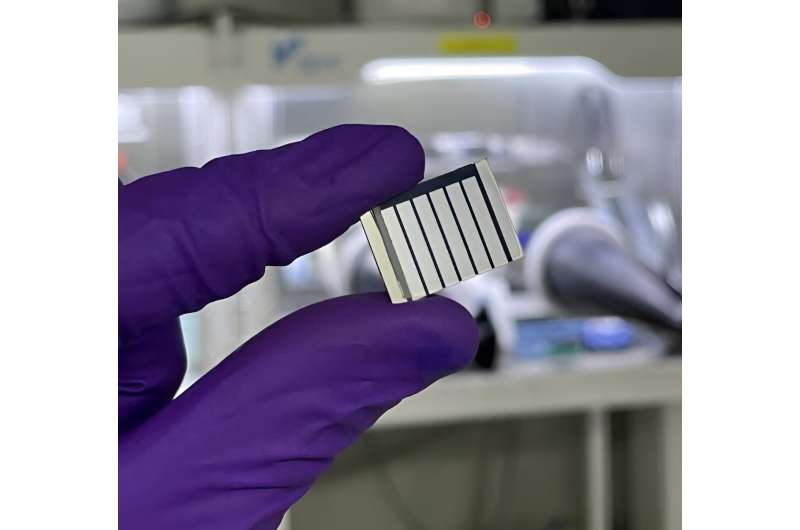
In a study published in Nature, researchers from the Hefei Institutes of Physical Science (HFIPS) of the Chinese Academy of Sciences have proposed a new and promising method of fabricating homogenized perovskite films for solar cells. The process involves inhibiting phase segregation caused by internal cation inhomogeneity to increase conversion efficiency to 26.1%, thus tying the existing record.
For solar cells, an important alternative energy source, the pursuit of higher conversion efficiency and the attempt to keep the cells stable as long as possible are core issues that scientists and engineers all over the world are trying to address.
Lead-halide perovskite solar cells (PSCs) have been extensively studied due to their high efficiency, but a dramatic slowdown in the conversion efficiency growth rate of these cells can be seen. Notably, most previous studies of these cells have been limited to the surface, dopant, and component levels.
In contrast, Pan Xu, a solar cell scientist at HFIPS, and his team decided to look deeper—to the phase level.
Based on years of work in the field, the scientists realized that phase segregation inevitably takes place inside perovskite films, thus affecting or, more precisely, harming both the conversion efficiency and stability of the cells.
-
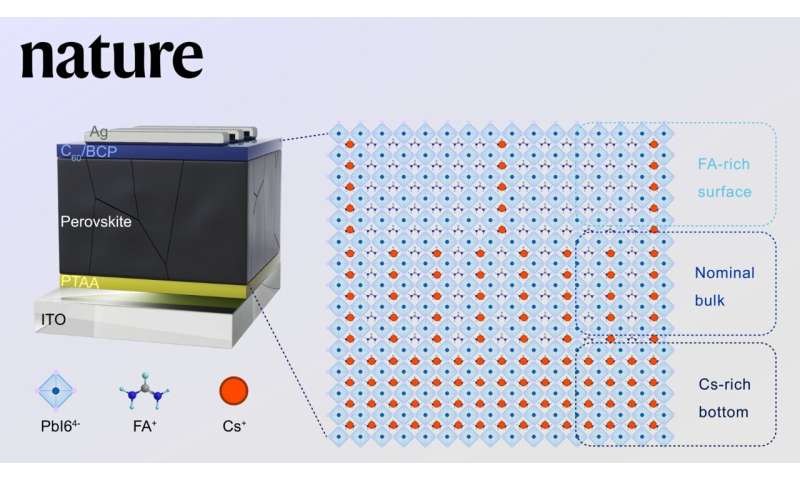
Scientists propose perovskite films homogenizing strategy to increase conversion efficiency. Credit: HFIPS -
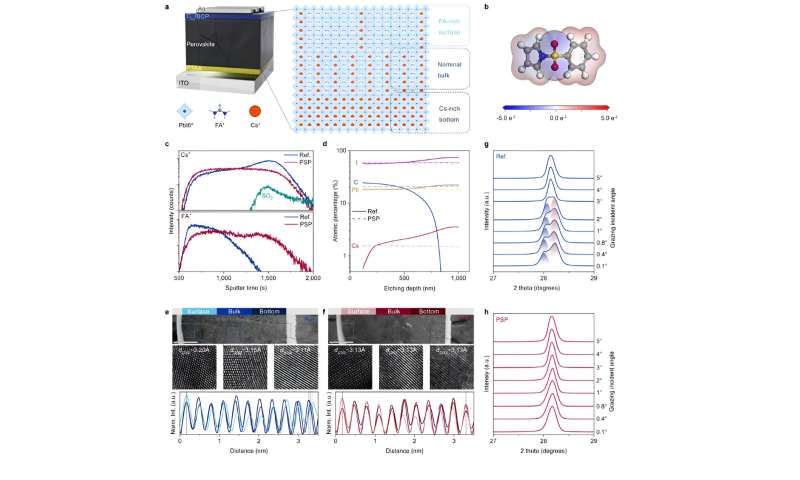
a. Illustration graph of inhomogeneous phase distribution caused by out-of-plane FA-Cs segregation. b. Electrostatic potential (ESP) image and molecular structure of PSP. c. Cationsdistribution obtained from Time-of-flight secondary ion mass spectroscopy (ToF-SIMS). d. Atomic percentage profile of the reference (solid line) and the PSP (dash line) extracted from depth-dependent XPS measurements. e-f. High-angle annular dark field (HAADF) transmission electron microscopy images for the reference sample (e) and the PSP treated sample (f) (scale bars refer to 200 nm). g-h. Enlarged GIXRD spectra collected from the bottom side of the reference (g) and PSP (h) treated perovskite films. Credit: Pan's team
"We all know from previous work that cations in different groups are distributed inhomogeneously," said Pan. "But how exactly these cations are distributed and the reasons behind it and how it affects efficiency remain unclear."
To understand how cations behave in perovskite films, the researchers used experimental approaches to quantify how the cations FA+ and Cs+ were distributed vertically.
"Cs+ likes to aggregate at the bottom of the film, while a large amount of FA+ gathered at the upper interface of the film," said PAN.
To verify this, they carried out further work by studying distribution in the crystalline phase. These experiments all agreed well with each other. The team was thus the first to clearly observe out-of-plane inhomogeneous distribution in a laboratory experiment.
Nevertheless, the researchers also wanted to know the reason for this distribution pattern and what to do about it. So they conducted an in-situ test to determine the exact mechanism behind this inhomogeneity.
"Then we found that cations in different groups crystallize and transform at very different rates," said Pan, who believed this was the reason for the inhomogeneity. Once the researchers identified the key problem, they proposed a strategy of using 1-(Phenylsulfonyl)pyrrole (PSP) as an additive to make up for the difference in crystallization and phases transition rates in order to produce homogeneous films.
-
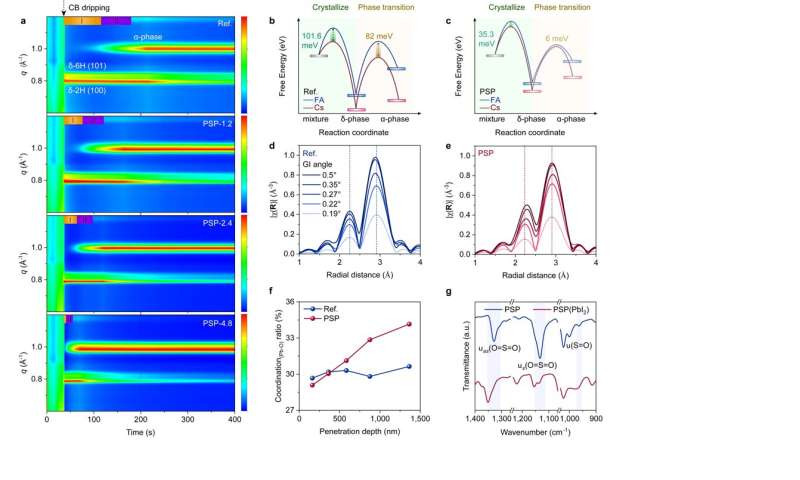
a. In-situ synchrotron radiation grazing incidence wide angle X-ray scattering (in-situ GIWAXS). b-c. The schematics of computation results for free energy evolution in the reference system (b) and PSP system (c) during the processes of crystallization and phase transition. d-e. Plots of Fourier Transform R space results of EXAFS measurements. (f) Diagram of calculated Pb-O coordination ratio from the EXAFS measurements. (g) FTIR spectra patterns of PSP and PSP(PbI2) complex. Credit: Pan's team -
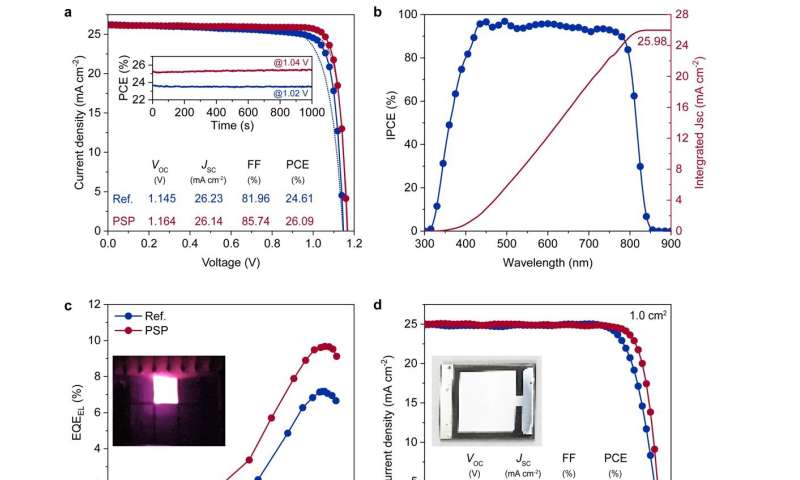
a. J-V curves of champion p-i-n PSCs in the lab scale. The active area was around 0.073 cm2. The detailed PV parameters from reverse scan and SPO curves were inset in the figure. b. incident photon-to-electron conversion efficiency (IPCE) plots of the PSP solar cells. The solid line with red color is integrated JSC. c. EQE curves measured from the reference and PSP solar cells in the LED mode. The inside photo is the PSCs working in LED mode. d. J-V curves of upscaled PSCs with and without PSP. The inside photo is the upscaled PSCs with 1 cm2 active area. e. Normalized PCE evolution curves of the unencapsulated reference and PSP devices under continuous tracking at maximum power point (MPP) followed ISOS L-1I protocol. f. Damp-heat reliability test results of the encapsulated devices tested at 85 °C and 85% relative humidity (RH) followed ISOS D-3 protocol. Credit: Pan's team
The researchers were pleased to see a significant increase in conversion efficiency to 25.8% under third-party certification. What's better, the cells showed long-term, good stability, with conversion efficiency remaining as high as 92% of the original value even after 2,500 hours of maximum power point tracking.
According to public reports, this ties the record in conversion efficiency. All in all, Pan and his team's work on phase optimization for solar cells suggests a promising technological path for improving solar cell conversion efficiency and stability.
More information: Out-of-plane cations homogenise perovskite composition for solar cells, Nature (2023). DOI: 10.1038/s41586-023-06784-0


















